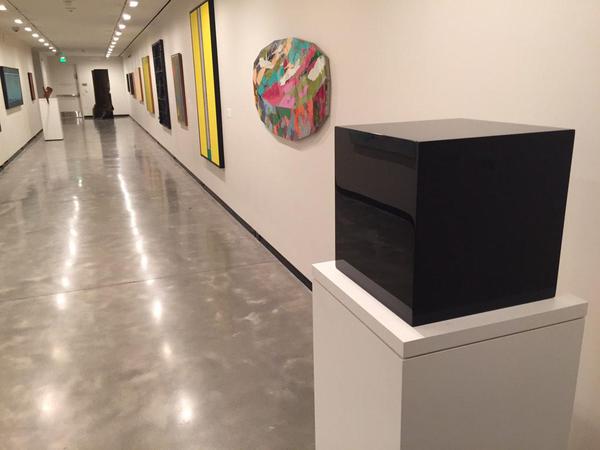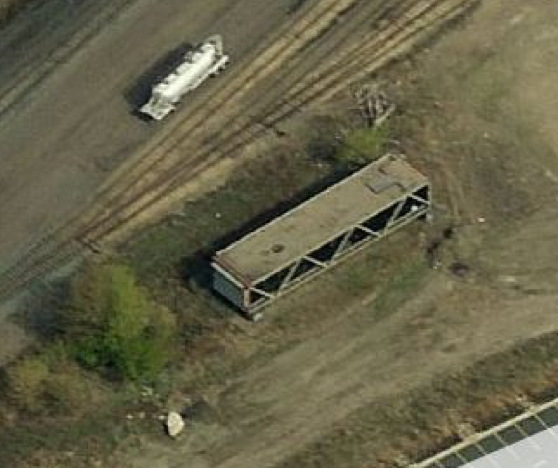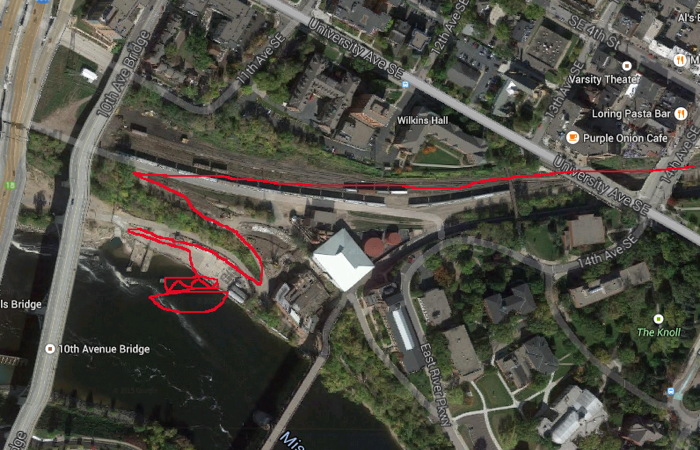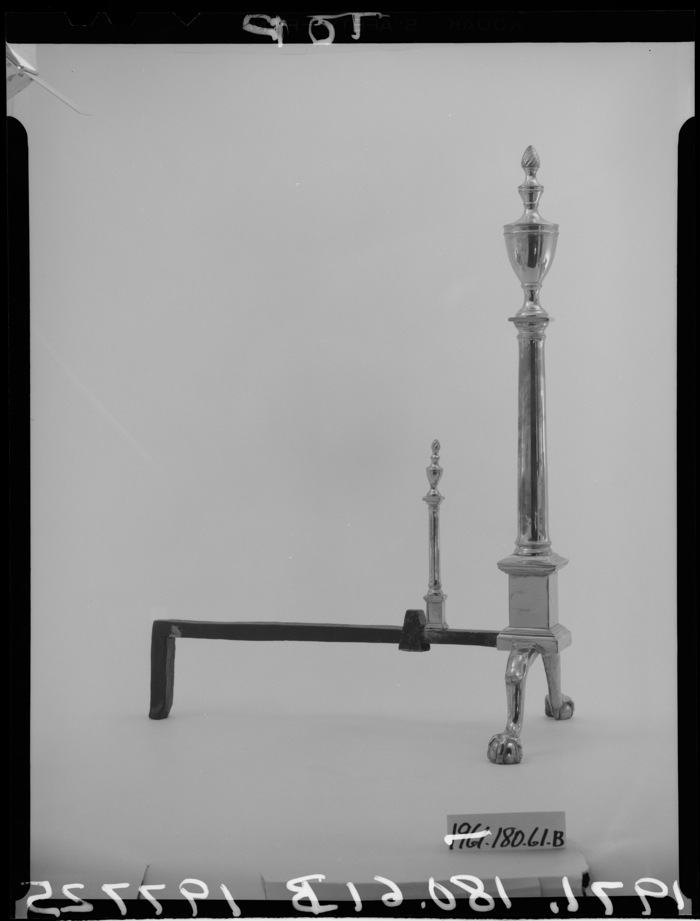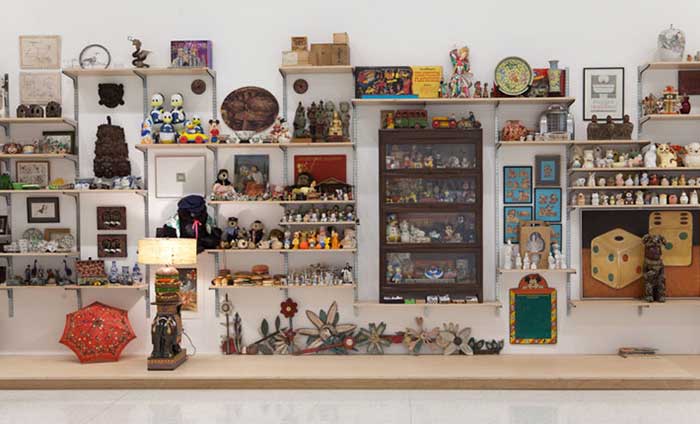
Lavorare e un Brutto Mestiere, (Working is a Bad Job), 1993, installed in Aperto '93 Emergency/Emergenza, 45th Venice Biennale. image: from all over, but this time via contemporaryartnow
Maurizio Cattelan was invited to contribute work to Aperto '93 at the Venice Biennale. Aperto's shows-within-a-show format, conceived by FlashArt editors Helena Kontova and Giancarlo Politi and curated by Kontova and twelve others, focused on emerging artists and would prove highly influential.
Cattelan offered his space to Gruppo Armando Testa in Torino, the head office of Italy's largest advertising agency, which had just been taken over by the deceased founder's son Marco. Cattelan said he "assigned" it, but he is often described as having leased his space; he also signed a contract with Testa to promote whatever they decided to display.
According to an article at the time titled "L'Arte Cerca Publicitta [Art Seeks Advertising]" Testa decided to use the Biennale opportunity as a teaser for the launch of a new perfume by Roman fashion designer Pino Lancetti. Though the licensing company Schiapparelli's logo is in the corner, Lancetti's name is only visible obliquely on the bottle. The perfume turned out to be called Suspense.
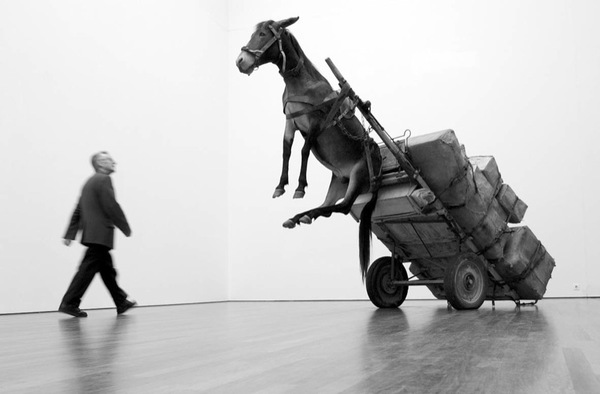
Untitled, 2002, photo: perrotin
Cattelan told FlashArt the project was meant to "encourage people to reflect on the internal working of the Aperto." In 2005 a nameless Sotheby's cataloguer wrote, "By allowing an exterior, non-artistic, body to infiltrate this sanctified world he was exploring the hierarchies and politics of choice which selects the participants." What's not quite clear is the degree to which the art informed the advertising. It's hard to tell the cart from the horse, much less tell who's in front.
The world of the Biennale was not so edenic as the auctioneer imagined, nor was Cattelan's gesture its Original Sin; biblically speaking, art and advertising already knew each other's bodies very well. Armando Testa had been prominent in the Italian art world, and aspired to "pure art's" ability "to play with ambiguity." Lancetti, the client, trained and identified as a painter, and he was known for creating several collections using imagery from artists like Kandinsky and Picasso. Elsewhere in the Arsenale, another Aperto curator installed crotch shots by Oliviero Toscani, the famously iconoclastic ad man for Benetton. All that was left, directionally, was for an artist to reciprocate the ad love.
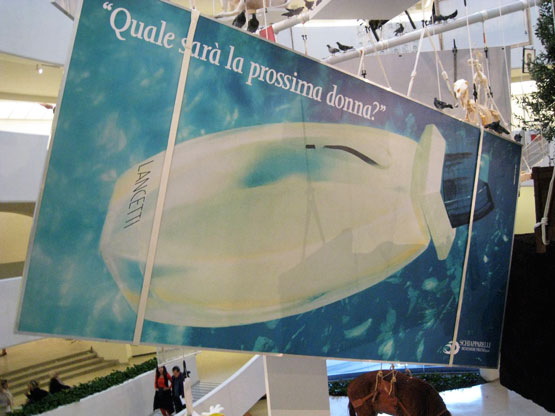
Lavorare e un Brutto Mestiere, 1993, installed in the Guggenheim, 2011, photo: jill krementz/nysd
Cattelan eventually sold the 3x6m billboard as an artwork titled Lavorare e un Brutto Mestiere, (Working is a Bad Job). Surprisingly, maybe a little ironically, it later took two attempts, in 2005 and 2006, for Sotheby's to sell Lavorare for just 10,200GBP. On a square inch basis, that's probably the cheapest Cattelan of the century. Like everything else, it hung in the Guggenheim rotunda in 2011. [above] [UPDATE: The Rubells got it, well done, as usual.]
I thought of all this this morning [except the auctions, which I hadn't known, but now regret missing] when I saw the latest addition handwritten Post-It note in Hans Ulrich Obrist's Instagram feed, which was from Paul Chan. Technically, I saw the autotweet first: "Letter from Paul Chan EROTIC ROMANCE IS THE FUTURE!!"

Paul Chan's @badlandsunlmtd note in @hansulrichobrist's IG today
Unlike the series' typical self-conscious banalities or Deep Thoughtz, Paul's note sounded unexpectedly promotional. Because I'd recently received an invite to the launch of Badlands Unlimited's New Lovers erotic fiction collection. Then I clicked through to HUO's pic of Chan's note, and it's not a Post-It at all! That's what he means by "letter." And "#LilithWes." Paul sent Hans Ulrich a note with the books. Which, you go, Paul! I'm an admirer of both their work, and have only ever had engaging, genial interactions with either of them. But this felt like a shift, a disruption in the making.
I'm thinking HUO's leaving a lot of mindshare on the table. Most of HUO's notes respond to his request for a thought, and most all those thoughts at that moment are non-promotional. [An inevitable exception: Alex Israel, who can never not promote himself.] But HUO's got like 90,000 followers. Once you move beyond the initial "it's a personal brand boost to be asked for a Post-It note," why wouldn't you artfully pitch your book? Or obliquely reference the work in your upcoming show? There's a lot of promotional room to travel between HUO's status quo and Alex Israel.
Which is how and why I came up this project:
Like a director who always has his thank you speech in his pocket if he needs it, I will make sure that whenever Hans Ulrich gets around to asking me, I'll have something on point and monetizable to scribble down. And that's the witty brand message or hashtag that I've been supplied with, exclusively, by a thinkfluential social media professional. Email for rates and terms.
Your message can't be too terribly time sensitive, of course, since there's no telling when HUO's tap is gonna come. With kids and shows and all, we don't hang out as much as we used to. But with an/your important message in place, I would definitely make it a subtle priority to make it happen. If it doesn't, of course, well, that's HUO. I'll gladly write your content on a Post-It note and help get the word out in my own channels as a make-good. The important thing is the concept, and that we tried.

